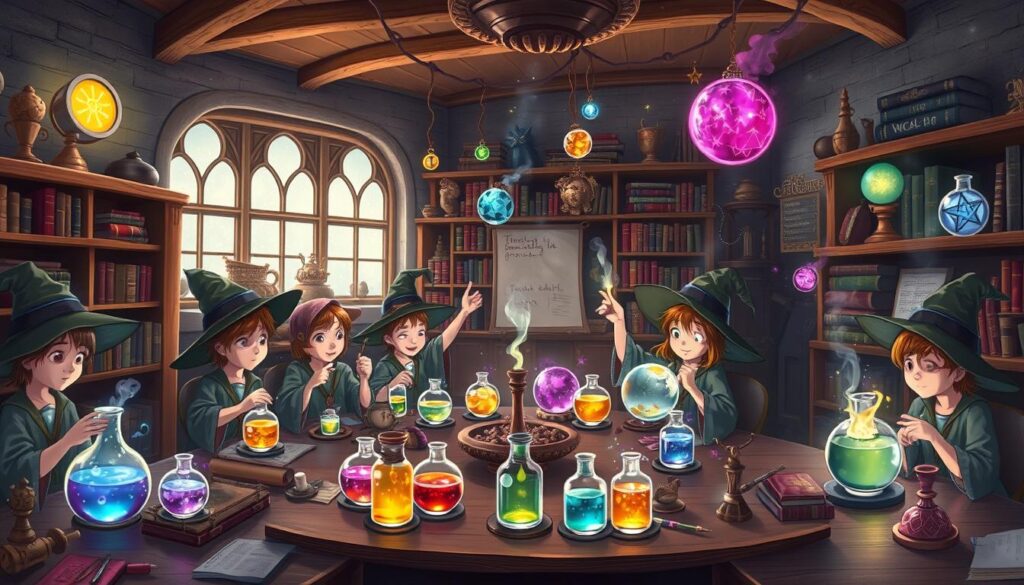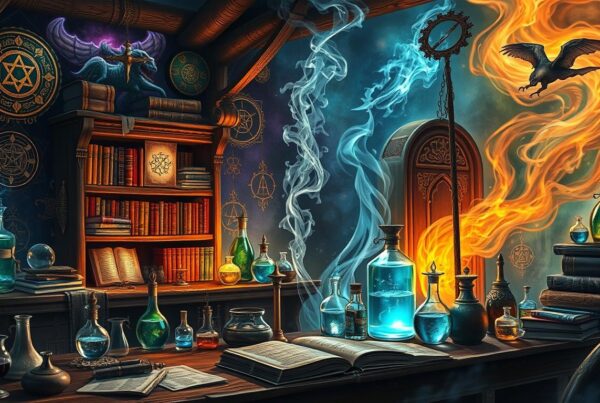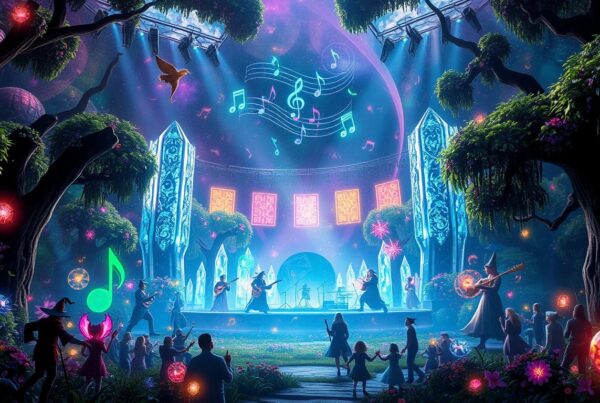The magical journey of young wizards begins with their acceptance into the most prestigious wizarding schools, such as Hogwarts School of Witchcraft and Wizardry and Ilvermorny School of Witchcraft and Wizardry. These institutions offer a comprehensive wizarding education, where students are sorted into houses and immersed in the study of various magical subjects. The curriculum at both schools encompasses core classes like Charms, Transfiguration, Potions, and Defense Against the Dark Arts, as well as elective subjects such as Divination and Care of Magical Creatures.
From the moment they step into these hallowed halls, young wizards embark on a path of magical studies that will shape their lives and abilities. The dedicated faculty at Hogwarts and Ilvermorny guide students through the intricacies of spellcasting, potion brewing, and understanding the magical world around them. Through a well-rounded magical curriculum, these schools aim to nurture the talents and potential of each young wizard, preparing them for the challenges and opportunities that await them in the wizarding world.
Key Takeaways
- Hogwarts and Ilvermorny are two of the most prestigious wizarding schools that offer comprehensive magical education.
- Young wizards begin their magical journey at the age of eleven when they are accepted into these schools and sorted into houses.
- The curriculum includes core classes such as Charms, Transfiguration, Potions, and Defense Against the Dark Arts, as well as elective subjects.
- Dedicated faculty guide students through the intricacies of spellcasting, potion brewing, and understanding the magical world.
- The schools aim to nurture the talents and potential of each young wizard, preparing them for the challenges and opportunities in the wizarding world.
The Magical Journey Begins: Early Childhood Education for Young Wizards
For young witches and wizards, the path to mastering magic begins long before they step foot in prestigious schools like Hogwarts or Ilvermorny. Early magical education is crucial in nurturing their innate abilities and preparing them for the challenges ahead. Wizarding families play a vital role in this process, providing a supportive environment that fosters their children’s magical growth and development.
From the moment they display their first signs of magic, often as toddlers or preschoolers, young wizards embark on a magical upbringing guided by their parents and extended family members. Through engaging activities and gentle guidance, they learn to control and channel their powers, laying the foundation for their future magical studies.
Many wizarding families opt for homeschooling in these early years, creating personalized curricula that cater to their children’s unique strengths and interests. Others may send their young ones to local magical playgroups or primary schools, where they can interact with other magical children and begin to develop essential social skills.
“My parents always encouraged me to explore my magic, even when I accidentally levitated the family cat or turned my brother’s hair blue. They taught me that magic was a gift to be cherished and used responsibly.” – Luna Lovegood, reflecting on her early magical education.
As childhood wizards grow older, their magical education becomes more structured and comprehensive. They learn the basics of wand handling, potion brewing, and simple spells, all while absorbing the rich history and traditions of the wizarding world. Parents and guardians work closely with their children, answering questions, providing guidance, and instilling a love for learning that will serve them well throughout their magical journeys.
By the time they are ready to attend formal magical schools, these young wizards have already developed a strong foundation in the magical arts. Their early magical education, nurtured by the love and support of their wizarding families, has prepared them to embrace the challenges and opportunities that await them in the halls of Hogwarts, Ilvermorny, and beyond.
Ilvermorny: The American School of Witchcraft and Wizardry
Nestled in the heart of Massachusetts, Ilvermorny stands as a beacon of magical education in the United States. Founded in the 17th century by Isolt Sayre and James Steward, this prestigious institution has a rich history and unique traditions that set it apart from its European counterparts. Let’s delve into the fascinating world of Ilvermorny and explore its houses, sorting ceremony, and curriculum.
History and Founding of Ilvermorny
The story of Ilvermorny’s founding is one of love, courage, and determination. Isolt Sayre, a descendant of Salazar Slytherin, fled her native Ireland to escape her cruel aunt and made her way to the New World. There, she met and fell in love with James Steward, a No-Maj (non-magical person). Together, they built a small cottage on Mount Greylock and began teaching magic to their adopted children, Chadwick and Webster Boot. As word of their magical abilities spread, more students sought out their guidance, and thus, Ilvermorny was born.
Houses and Sorting Ceremony at Ilvermorny
Ilvermorny is home to four distinct houses, each named after a magical creature that plays a significant role in the school’s history:
- Horned Serpent: Represents the mind and favors scholars
- Wampus: Represents the body and favors warriors
- Thunderbird: Represents the soul and favors adventurers
- Pukwudgie: Represents the heart and favors healers
The sorting ceremony at Ilvermorny is a unique and enchanting experience. New students step onto a Gordian Knot on the floor, and the magical carvings of the four houses react to indicate which house the student belongs to. It is not uncommon for more than one carving to respond, giving the student a choice between the selected houses.
Curriculum and Subjects Taught at Ilvermorny
Ilvermorny’s curriculum is similar to that of its European counterpart, Hogwarts, with a focus on core magical subjects such as Charms, Transfiguration, Potions, and Defense Against the Dark Arts. However, the school also offers a range of electives that reflect the diverse magical traditions of the Americas, such as:
- Arithmancy
- Xylomancy
- Study of Ancient Runes
- Care of Magical Creatures
Students at Ilvermorny are encouraged to explore their magical abilities and develop their skills in a supportive and inclusive environment. The school’s dedicated faculty, which includes some of the most talented witches and wizards in the United States, guides students through their magical education, preparing them for the challenges and opportunities that await them in the wizarding world.
| House | Founder | Traits |
|---|---|---|
| Horned Serpent | Isolt Sayre | Scholars, Intellect |
| Wampus | Webster Boot | Warriors, Body |
| Thunderbird | Chadwick Boot | Adventurers, Soul |
| Pukwudgie | James Steward | Healers, Heart |
As the American wizarding community continues to grow and evolve, Ilvermorny remains a cornerstone of magical education, nurturing generations of talented witches and wizards who will shape the future of magic in the United States and beyond.
Hogwarts School of Witchcraft and Wizardry: A Comprehensive Guide
Nestled in the heart of the Scottish Highlands, Hogwarts School of Witchcraft and Wizardry stands as a beacon of magical education, drawing young wizards and witches from across the United Kingdom. With a rich history spanning over a thousand years, Hogwarts has become synonymous with excellence in magical instruction, nurturing generations of talented and influential witches and wizards.

The Four Founders and Houses of Hogwarts
Hogwarts was founded around 990 A.D. by four of the greatest witches and wizards of the age: Godric Gryffindor, Helga Hufflepuff, Rowena Ravenclaw, and Salazar Slytherin. Each of these legendary Hogwarts founders established a house that bears their name and embodies their unique values and qualities.
- Gryffindor: Known for bravery, chivalry, and courage
- Hufflepuff: Celebrated for loyalty, dedication, and hard work
- Ravenclaw: Renowned for wit, learning, and wisdom
- Slytherin: Recognized for ambition, cunning, and resourcefulness
Upon arrival at Hogwarts, students are sorted into one of these four houses by the enchanted Sorting Hat, which takes into account their personality traits, aptitudes, and preferences. This sorting ceremony marks the beginning of a student’s journey within their Hogwarts house, where they will forge lifelong friendships, engage in friendly rivalries, and strive to earn points for their house.
The Hogwarts Curriculum: Core Classes and Electives
The Hogwarts curriculum is designed to provide students with a comprehensive magical education, covering a wide range of subjects essential for their growth as witches and wizards. The core classes at Hogwarts include:
- Charms: Mastering the art of casting spells and enchantments
- Transfiguration: Learning to transform objects and beings
- Potions: Brewing magical elixirs and concoctions
- Defense Against the Dark Arts: Developing skills to protect against dark magic
- Herbology: Studying magical plants and their properties
- History of Magic: Exploring the rich tapestry of wizarding history
- Astronomy: Observing the stars and celestial bodies
In addition to these core subjects, Hogwarts offers a variety of elective courses for students to pursue their individual interests and talents. These electives include:
- Divination: Unraveling the mysteries of the future through various methods
- Care of Magical Creatures: Understanding and caring for fantastic beasts
- Arithmancy: Studying the magical properties of numbers
- Ancient Runes: Deciphering ancient scripts and symbols
- Muggle Studies: Examining the non-magical world and its customs
Through this diverse curriculum, Hogwarts aims to equip students with the knowledge, skills, and values necessary to become accomplished witches and wizards, ready to contribute to the magical world.
Extra-Curricular Activities and Student Life at Hogwarts
Life at Hogwarts extends far beyond the classroom, offering students a rich array of extra-curricular activities and opportunities for personal growth. One of the most popular and celebrated activities is Quidditch, the wizarding world’s premier sport. Each Hogwarts house fields its own Quidditch team, competing in thrilling matches throughout the school year.
Other notable extra-curricular activities include:
- The Dueling Club: Honing defensive and offensive magical skills
- The Slug Club: An exclusive society for talented and well-connected students
- Charms Club: Exploring advanced charmwork and spellcasting
- Gobstones Club: Engaging in a popular wizarding board game
- Frog Choir: Showcasing musical talents and performing with enchanted frogs
Beyond these structured activities, Hogwarts student life is characterized by the camaraderie and friendships forged within the houses. The common rooms serve as hubs for socializing, studying, and relaxing, while the Great Hall plays host to daily meals and special feasts. The enchanted ceiling of the Great Hall mirrors the sky outside, providing a breathtaking backdrop for the lively conversations and laughter that fill the room.
In conclusion, Hogwarts School of Witchcraft and Wizardry stands as a testament to the wonders of magical education, offering students an unparalleled opportunity to cultivate their magical abilities, forge lifelong bonds, and embark on a journey of self-discovery. With its rich history, diverse curriculum, and vibrant student life, Hogwarts truly is a place where magic comes alive.
Wands and Wandlore: Choosing the Right Wand for Young Wizards
For young witches and wizards, the wand is an essential tool that channels and focuses their magical energy. Each wand is unique, crafted from a specific type of wood and containing a magical core, such as phoenix feather, dragon heartstring, or unicorn hair. The process of choosing a wand is a significant moment in a young wizard’s life, as the wand must be well-suited to its owner’s magical abilities and personality.
Wandlore, the study of the history and magical properties of wands, is a fascinating subject that delves into the intricacies of wand craftsmanship and the relationship between a wand and its owner. Renowned wandmakers, such as Ollivander in Great Britain and Johannes Jonker in America, possess a deep understanding of wandlore and are skilled in matching wands to their ideal owners.
When choosing a wand, several factors come into play, including the wand’s length, flexibility, and the materials used in its construction. Wands typically range from 9 to 14 inches in length, with some exceptions on either end of the spectrum. The flexibility of a wand can also influence its compatibility with its owner, with some wizards preferring a more rigid wand for precise spellcasting, while others may find a more flexible wand better suited to their style of magic.
| Wand Core | Characteristics |
|---|---|
| Phoenix Feather | Versatile, capable of the greatest range of magic, and shows initiative |
| Dragon Heartstring | Powerful, easy to learn spells, and prone to accidents |
| Unicorn Hair | Consistent magic, least susceptible to fluctuations and blockages, most faithful |
The wand core is perhaps the most crucial aspect of a wand, as it determines the wand’s magical properties and influences the types of spells it excels at casting. Phoenix feather, dragon heartstring, and unicorn hair are among the most common wand cores, each with its own unique characteristics.
“The wand chooses the wizard. That much has always been clear to those of us who have studied wandlore.” – Garrick Ollivander
Ultimately, the process of choosing a wand is a deeply personal experience, as the wand must resonate with its owner’s magical signature. As the famous wandmaker Garrick Ollivander once said, “The wand chooses the wizard.” It is a bond that cannot be forced or manufactured, but rather one that develops naturally when the right wand finds its rightful owner.
The Education of Young Wizards: From Baby Steps to Advanced Magic
The education of young wizards is a gradual process that begins with the basics of magical theory and simple spells, progressing to more advanced magic as students master foundational skills. This magical education progression ensures that students develop a strong understanding of the fundamentals before delving into more complex and challenging aspects of magic.
First-year students at magical institutions like Hogwarts and Ilvermorny learn essential spells such as the Levitation Charm (Wingardium Leviosa) and the Unlocking Charm (Alohomora). These spells serve as the building blocks for their magical skill development, allowing them to gain confidence and proficiency in their abilities.
“The journey of a thousand miles begins with one step.” – Lao Tzu
As students progress through their magical education, they tackle more complex magic, such as the Patronus Charm and nonverbal spells. These advanced magic techniques require a deeper understanding of magical theory and a higher level of skill, which students acquire through diligent study and practice.
By their final years, students are prepared to take their Ordinary Wizarding Levels (O.W.L.s) and Nastily Exhausting Wizarding Tests (N.E.W.T.s) to demonstrate their mastery of various magical subjects. These exams are a testament to the students’ magical skill development and their readiness to enter the magical world as fully-fledged witches and wizards.
| Year | Spells Learned | Magical Skill Development |
|---|---|---|
| 1st Year | Levitation Charm, Unlocking Charm | Basic magical theory, simple spells |
| 3rd Year | Patronus Charm, Cheering Charm | Intermediate magic, emotional control |
| 5th Year | Vanishing Spell, Stunning Spell | Advanced magic, nonverbal spells |
| 7th Year | Protean Charm, Fidelius Charm | Mastery of magical subjects, N.E.W.T.s |
The magical education progression at schools like Hogwarts and Ilvermorny ensures that young wizards are well-prepared to face the challenges of the magical world. Through a combination of theoretical knowledge and practical application, students develop the skills and confidence necessary to become successful and responsible members of the wizarding community.
Mastering the Fundamentals: Charms, Transfiguration, and Potions
As young wizards and witches embark on their magical education, mastering the fundamental disciplines of Charms, Transfiguration, and Potions is crucial for their growth and success. These core subjects form the foundation of a well-rounded magical education, equipping students with the skills and knowledge necessary to navigate the magical world.

Charms: The Building Blocks of Wizardry
In Charms class, students learn to manipulate objects and creatures through the use of specific incantations and wand movements. Professor Filius Flitwick, the Charms Master at Hogwarts, introduces students to a wide range of charms, from the simple Wand-Lighting Charm (Lumos) to more advanced spells like the Cheering Charm.
“Charms are the building blocks of wizardry. They allow us to manipulate the world around us, bringing joy, light, and laughter to our lives.” – Professor Filius Flitwick
Transfiguration: The Art of Transformation
Transfiguration class focuses on the art of transforming one object or creature into another. This complex and challenging subject requires immense concentration, precision, and skill. Under the guidance of esteemed professors like Albus Dumbledore and Minerva McGonagall, students learn to master transformations ranging from turning a match into a needle to more advanced human transfiguration.
| Year | Transfiguration Curriculum |
|---|---|
| First Year | Match to needle, animal to object transformations |
| Second Year | Beetle buttons, reversing transformations |
| Third Year | Teapot to tortoise, Animagus theory |
| Fourth Year | Cross-species switches, Vanishing Spells |
| Fifth Year | Vanishing Spells, O.W.L. preparation |
| Sixth Year | Human Transfiguration, Conjuring Spells |
| Seventh Year | Advanced Human Transfiguration, N.E.W.T. preparation |
Potions: Brewing Success in the Magical World
In Potions class, students learn the intricate art of brewing magical elixirs and concoctions. From the simple Cure for Boils to the complex Polyjuice Potion, students must follow precise instructions and use the correct ingredients to achieve the desired effects. Potions Masters like Severus Snape and Horace Slughorn guide students through the fascinating world of potion-making, emphasizing the importance of precision, patience, and creativity.
- Wizards who are unable to master transfiguration beyond what school teaches may face dangerous consequences.
- Success rate of completing the match to needle transfiguration exercise in standard wizarding first years is low.
- Importance of focus in mastering transfiguration, a vital yet challenging skill for beginner wizards and witches.
- Risks associated with attempting transfiguration beyond one’s magical ability, especially when involving classmates.
By mastering the magical fundamentals taught in Charms, Transfiguration, and Potions classes, young wizards and witches lay the groundwork for a successful and fulfilling magical education. These core subjects not only provide essential skills but also foster critical thinking, problem-solving, and creativity, preparing students for the challenges and opportunities that await them in the magical world.
Defense Against the Dark Arts: Preparing Young Wizards for Challenges
Defense Against the Dark Arts (DADA) is an essential subject in the magical curriculum, equipping young wizards with the skills and knowledge needed to protect themselves against dark magic, dangerous creatures, and malicious spells. From the moment they step into the classroom, students embark on a journey of learning how to identify and counter various threats that they may encounter in the magical world.
DADA classes cover a wide range of topics, starting with fundamental defensive spells like the Disarming Charm (Expelliarmus) and progressing to more advanced magic, such as the Patronus Charm, which is used to repel Dementors. Throughout their education, young wizards gain hands-on experience in dealing with dark creatures, including Boggarts, Grindylows, and Werewolves. They also learn how to resist the Imperius Curse and other forms of dark magic that may be used against them.
The Dark Arts are many, varied, ever-changing, and eternal. Fighting them is like fighting a many-headed monster, which, each time a neck is severed, sprouts a head even fiercer and cleverer than before. You are fighting that which is unfixed, mutating, indestructible.
The importance of Defense Against the Dark Arts cannot be overstated, as it prepares young wizards to face the challenges that lie ahead in the magical world. With each lesson, students grow more confident in their abilities to defend themselves and others, becoming well-equipped to handle the dangers that may cross their paths.
| Year | DADA Topics Covered |
|---|---|
| First Year | Basic defensive spells, Dark creatures (Doxies, Imps) |
| Second Year | Cornish Pixies, Disarming Charm, Tongue-Tying Curse |
| Third Year | Boggarts, Grindylows, Werewolves, Riddikulus Charm |
| Fourth Year | Unforgivable Curses, Resisting Imperius Curse |
| Fifth Year | Defensive Charms, Patronus Charm, Dementors |
| Sixth Year | Nonverbal spells, Resisting Veritaserum, Dementors |
| Seventh Year | Advanced defensive magic, Fiendfyre, Inferi |
By the time they complete their magical education, young wizards will have gained a solid foundation in Defense Against the Dark Arts, enabling them to face the world with the confidence and skills needed to protect themselves and others from the forces of darkness.
Exploring Electives: Divination, Care of Magical Creatures, and More
Beyond the core classes at Hogwarts School of Witchcraft and Wizardry, students have the opportunity to delve into a variety of fascinating elective classes that cater to their individual interests and strengths. These magical electives allow young wizards to expand their knowledge and skills in specific areas of magic, preparing them for future careers and adventures in the wizarding world.
One of the most intriguing elective classes offered at Hogwarts is Divination. This subject focuses on unraveling the mysteries of the future through various methods, such as reading tea leaves, gazing into crystal balls, and interpreting dreams. Students who possess a natural gift for prophecy and intuition often find themselves drawn to this elective, eager to hone their skills and gain insight into what lies ahead.
Divination: Unraveling the Mysteries of the Future
“Divination is one of the most imprecise branches of magic. I shall not conceal from you that I have very little patience with it.” – Professor Minerva McGonagall
Despite the skepticism surrounding Divination, many students find the subject captivating and enlightening. They learn to read the signs and symbols that the universe presents, seeking guidance and warnings from the beyond. Notable Hogwarts students who excelled in Divination include:
- Sybill Trelawney, who later became the Divination professor at Hogwarts
- Parvati Patil, who showed a keen interest and talent for the subject
- Lavender Brown, who often consulted her Divination textbooks for guidance
Care of Magical Creatures: Understanding and Respecting Fantastic Beasts
Another popular elective class at Hogwarts is Care of Magical Creatures. This hands-on subject teaches students about the wide range of fantastic beasts that inhabit the magical world, from the gentle unicorn to the fearsome dragon. Students learn how to properly care for, interact with, and respect these incredible creatures, gaining a deeper appreciation for the diversity and beauty of the magical world.
| Creature | Characteristics | Notable Students |
|---|---|---|
| Hippogriff | Proud, easily offended, requires respect | Harry Potter, Hermione Granger |
| Niffler | Attracted to shiny objects, mischievous | Newt Scamander |
| Bowtruckle | Small, twig-like, guards wand-wood trees | Luna Lovegood |
In addition to Divination and Care of Magical Creatures, Hogwarts offers a range of other elective classes, such as Arithmancy, the study of the magical properties of numbers, and Ancient Runes, which focuses on the interpretation of runic scripts used in magic. These electives allow students to tailor their magical education to their interests and future aspirations, ensuring a well-rounded and fulfilling experience at Hogwarts.
The Role of Mentors and Teachers in Shaping Young Wizards
In the magical world of witchcraft and wizardry, the influence of mentors and teachers cannot be overstated. These magical mentors play a crucial role in shaping young wizards’ identities and guiding them through their educational journey. At Hogwarts, three exceptional educators stand out for their unique contributions to the development of their students: Albus Dumbledore, Minerva McGonagall, and Severus Snape.
Albus Dumbledore: The Wise and Powerful Headmaster
Albus Dumbledore, the wise and powerful headmaster of Hogwarts, is a beacon of guidance for students and staff alike. With his extensive knowledge and experience, Dumbledore serves as a mentor to many, including the famous Harry Potter. His calm demeanor and ability to see the best in people make him an invaluable source of support for young wizards navigating the challenges of their magical education.
Minerva McGonagall: The Strict but Fair Deputy Headmistress
Minerva McGonagall, the Deputy Headmistress and Transfiguration professor, is known for her strict but fair approach to teaching. Her unwavering commitment to her students’ well-being and success is evident in her every action. McGonagall’s high expectations and firm guidance help young wizards develop the discipline and skills necessary to excel in the magical world.
Severus Snape: The Complex and Misunderstood Potions Master
Severus Snape, the Potions Master, is a complex and often misunderstood figure at Hogwarts. Despite his stern demeanor and seemingly harsh treatment of students, Snape works tirelessly to protect his pupils and the school from dark forces. His expertise in potions and his role as a double agent demonstrate the depth of his commitment to the greater good, making him an essential mentor figure in the lives of young wizards.
“It is our choices, Harry, that show what we truly are, far more than our abilities.” – Albus Dumbledore
The impact of these magical mentors extends far beyond the classroom. They help shape young wizards’ understanding of the world, guiding them through the challenges of growing up and discovering their true identities. By providing support, wisdom, and guidance, Hogwarts teachers like Dumbledore, McGonagall, and Snape ensure that their students are prepared to face the complex realities of the magical world and emerge as confident, capable witches and wizards.
Beyond the Classroom: Extracurricular Activities and Clubs for Young Wizards
Extracurricular activities and magical clubs are essential components of a well-rounded education for young wizards. These activities provide students with opportunities to explore their interests, develop new skills, and form lasting friendships. At Hogwarts and Ilvermorny, students can participate in a wide range of extracurricular activities that cater to their unique talents and passions.
Quidditch, the most popular wizarding sport, is a thrilling game played on flying broomsticks. Students at both schools can try out for their house teams and compete in exciting matches throughout the school year. Quidditch not only promotes physical fitness and teamwork but also fosters a sense of house pride and healthy competition among students.
For those interested in honing their defensive magic skills, the Dueling Club is an excellent choice. Under the guidance of experienced instructors, students learn proper dueling techniques, practice defensive spells, and engage in supervised duels with their peers. The Dueling Club helps young wizards develop quick reflexes, strategic thinking, and confidence in their magical abilities.
In addition to sports and dueling, there are numerous student organizations that cater to a variety of interests. For example, the Slug Club at Hogwarts brings together students who have demonstrated exceptional talent or potential in various fields. Members of the Slug Club have the opportunity to network with influential witches and wizards, attend exclusive events, and gain valuable insights into different career paths.
| Extracurricular Activity | Benefits |
|---|---|
| Quidditch | Promotes physical fitness, teamwork, and house pride |
| Dueling Club | Develops defensive magic skills, quick reflexes, and confidence |
| Student Organizations (e.g., Slug Club) | Provides networking opportunities, career insights, and personal growth |
Other notable extracurricular activities and magical clubs include:
- Charms Club: Students explore advanced charmwork and create innovative spells
- Potions Club: Members experiment with unique potion ingredients and brewing techniques
- Transfiguration Society: Students delve into the intricacies of transformative magic
- Magical Creatures Club: Members learn about and interact with fascinating magical beasts
“Extracurricular activities and magical clubs are not just about having fun; they are about discovering who you are, what you love, and what you stand for.” – Albus Dumbledore
By participating in extracurricular activities and magical clubs, young wizards can expand their horizons, challenge themselves, and grow both personally and magically. These experiences shape their identities, strengthen their friendships, and prepare them for the diverse challenges they will face in the wizarding world and beyond.
Conclusion: The Importance of a Well-Rounded Magical Education
A well-rounded magical education is crucial for young wizards to reach their full potential and become successful members of the wizarding community. By mastering core subjects like Charms, Transfiguration, Potions, and Defense Against the Dark Arts, students develop a strong foundation in magical knowledge and practical skills. This comprehensive approach to magical development ensures that young wizards are equipped with the tools they need to tackle the challenges they may face in their future endeavors.
Exploring elective classes and participating in extracurricular activities further enhances a well-rounded magical education. These opportunities allow students to discover their passions, hone their talents, and develop a diverse skill set that will serve them well in their chosen careers. Moreover, the guidance and support of dedicated mentors and teachers, such as Albus Dumbledore, Minerva McGonagall, and Severus Snape, play a vital role in shaping young wizards into confident, capable, and responsible adults.
The camaraderie and friendly competition among peers at institutions like Hogwarts School of Witchcraft and Wizardry and Ilvermorny also contribute to a well-rounded magical education. These interactions foster personal growth, teamwork, and a sense of belonging within the magical community. By embracing the importance of a comprehensive magical education, young wizards can unlock their full potential and become successful contributors to the wizarding world.



